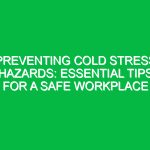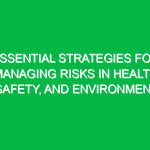Introduction
Making scaffolding is a critical task in construction and maintenance work, directly impacting health, safety, and environmental (HSE) standards. Proper scaffolding provides the necessary support for workers and materials, ensuring that tasks can be performed efficiently and safely at heights. The importance of understanding how to make scaffolding cannot be overstated, as improper scaffolding can lead to accidents, injuries, and even fatalities. In this article, we will explore the essential steps, components, and considerations involved in creating scaffolding that meets HSE safety standards.
The Fundamentals of Scaffolding
Before diving into the specifics of how to make scaffolding, it’s crucial to understand what scaffolding is and its various forms. Scaffolding is a temporary structure used to support a work crew and materials during construction or repair. It typically consists of wooden planks, metal poles, and safety features like guardrails and toe boards. The most common types of scaffolding include:
- Supported scaffolding: This type relies on a stable base, using poles and frames to create a platform.
- Suspended scaffolding: This form is suspended from a roof or building structure, ideal for high-rise projects.
- Rolling scaffolding: Mobile scaffolding on wheels, allowing easy movement across a job site.
Understanding these types is essential when deciding how to make scaffolding, as different projects may require different approaches.
Step-by-Step Guide: How to Make Scaffolding
1. Planning and Design
The first step in making scaffolding is thorough planning and design. This phase involves assessing the job site and understanding the specific needs of the project. Key considerations should include:
- Load requirements: Calculate the weight the scaffolding must support, including workers, materials, and equipment.
- Height and reach: Determine the height of the scaffolding needed to safely reach the work area.
- Ground conditions: Evaluate the stability of the ground where the scaffolding will be erected.
A detailed plan should also include the materials needed, such as scaffolding frames, planks, safety rails, and connectors. This planning phase is crucial for ensuring compliance with HSE guidelines and avoiding accidents.
2. Selecting the Right Materials
Selecting high-quality materials is essential in how to make scaffolding. Poor-quality materials can lead to structural failure and accidents. Key materials include:
- Scaffolding frames: These should be made of durable materials like galvanized steel or aluminum.
- Planks: Use solid wood or composite materials that can bear significant weight.
- Safety features: Ensure that guardrails and toe boards are included to prevent falls and material spillage.
Incorporating environmentally friendly materials can also enhance sustainability, aligning with HSE principles.
3. Assembly Process
Once the materials are selected, the next step is the assembly of the scaffolding. This process should follow a systematic approach:
- Establish a stable base: Ensure the ground is level and compacted. If necessary, use base plates to distribute weight.
- Assemble the frames: Connect the scaffolding frames securely, following the manufacturer’s instructions.
- Install the planks: Lay planks horizontally across the frames, ensuring they are securely fastened.
- Add safety features: Install guardrails and toe boards around the work platform.
During assembly, it’s imperative to have trained personnel overseeing the process to ensure adherence to safety standards.
4. Inspections and Safety Checks
After assembling the scaffolding, conducting thorough inspections is vital. This includes checking for:
- Structural integrity: Ensure all connections are secure and the framework is stable.
- Safety features: Verify that guardrails and toe boards are properly installed and meet height requirements.
- Load capacity: Confirm that the scaffolding can safely hold the intended load.
Implementing regular inspections throughout the project is essential for maintaining safety standards. If any issues arise, they should be addressed immediately.
5. Training and Safety Protocols
Training workers on how to use scaffolding safely is a critical component of HSE compliance. All personnel should be familiar with:
- Proper use of scaffolding: Understanding how to navigate and work on scaffolds safely.
- Emergency procedures: Knowing what to do in case of an accident or equipment failure.
- Personal protective equipment (PPE): Using helmets, harnesses, and other necessary gear to minimize risks.
Holding regular safety meetings can help reinforce these protocols and ensure that all workers are aware of best practices.
Potential Hazards and Risks
Despite careful planning and execution, scaffolding can pose several risks. Some common hazards include:
- Falls: The leading cause of injury in scaffold-related incidents, often due to improper use or lack of safety features.
- Structural failure: This can occur from overloading or using defective materials.
- Falling objects: Tools or materials can fall from scaffolding, posing risks to workers below.
Awareness of these hazards is crucial for implementing effective safety measures. Regular training and communication about risks can significantly reduce the likelihood of accidents.
Regulations and Standards
Compliance with local and international regulations is a non-negotiable aspect of scaffolding construction. In many regions, safety standards are governed by organizations such as the Occupational Safety and Health Administration (OSHA) in the United States or similar bodies in other countries. These regulations often dictate:
- Design specifications: Standards for scaffolding materials and configurations.
- Inspection protocols: Guidelines for regular checks to ensure compliance.
- Training requirements: Mandating safety training for all workers who work on or around scaffolding.
Understanding and adhering to these regulations is imperative for maintaining a safe work environment and avoiding legal repercussions.
Conclusion
Understanding how to make scaffolding is not just about constructing a physical structure; it’s about ensuring the safety and well-being of workers. By following the steps outlined in this guide, from planning and material selection to assembly and inspections, you can create a scaffold that adheres to HSE standards. The risks associated with scaffolding are significant, but with proper training, awareness, and adherence to regulations, they can be effectively managed. As you engage in construction or maintenance projects, prioritize safety and environmental considerations to foster a culture of health and safety in your workplace. Remember, a well-constructed scaffold is not just a tool; it is a foundation for safety and efficiency.


